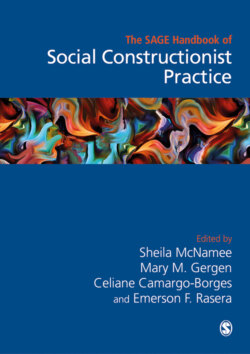Читать книгу The Sage Handbook of Social Constructionist Practice - Группа авторов - Страница 132
На сайте Литреса книга снята с продажи.
10 Researching Socio-material Practices: Inquiries into the Human/Non-human Interweave
ОглавлениеTanya Mudry and Tom Strong
Decades ago, Michael Polanyi (1966) wrote of there being a tacit dimension to much of what humans do and experience. This tacit dimension refers to taken-for-granted aspects of our experiencing and doing that occur below our attentional radar. Important for our considerations here is that such tacit experiencing and doing occurs because of the familiarities of our responsiveness to people and other features of our situations. Whether learning to pedal a bicycle or greeting a new colleague – beyond any initial awkwardness – these novel sense-making interactions often become familiar, lulling us into overlooking the tacit responsiveness required for enabling such interactions to recur. Should the familiar become tacit in these interactions, we can lose our sense of responding to how we are being responded to, unless such tacit interactions are disrupted or re-visited for new kinds of sense-making. This makes such interactions, or socio-material practices, interesting practitioner-research foci.
Interaction has been difficult to conceptualize for individually focused psychologists and socially oriented sociologists. Basically, it refers to the back-and-forth responsiveness that develops between people, or between people and material features in their situations. Goffman (1967) launched his micro-sociology suggesting that researchers look at the immediacies of everyday interactions as being ‘where the action is’. Garfinkel (1967) went a step further to suggest that everyday interactions – those recurring in the back and forth of people's immediate responses to each other – were how they brought familiar order to their relationships. Translated to human interactions with material elements (e.g., technology, objects, geography), a more challenging and recent socio-material view theorizes how humans become situationally ‘entangled’ (Barad, 2007) with material features of their lives.
Socio-material practices begin as responses to something new, in sense-making interactions that develop according to how people and material elements respond to each other in recurring interactions over time. A considerable literature has been developing, highlighting how interwoven humans and material phenomena have become (e.g., Grosz, 2017; Hekman, 2010) or may have always been (Ingold, 2007). New ‘posthuman’ (Braidotti, 2013) or relational ontologies (Barad, 2007) are discussed within this literature, particularly as technologies become more central in our lives (e.g., Fry, 2018; Latour, 2013). This literature suggests that it is becoming increasingly hard to distinguish human influence from the influence of socio-material phenomena with which we interact, particularly when one adds in Polanyi's tacit dimension. Therein lies a potentially interesting dilemma, as some practices, such as performed elegance or expertise (Dreyfus and Dreyfus, 1986) illustrate the usefulness of this tendency. However, a downside becomes evident when socio-material practices acquire an unwanted automaticity, such as when we become mindlessly ‘addicted’ to activities. Socio-material practices exemplify how humans routinely interact with material phenomena to reproduce experiences and relations, and effectively meld with these phenomena (e.g., technology, geographies, objects). Gregory Bateson (1972) similarly described how the practice of using a cane could seemingly develop into an extension of a visually impaired person using it.
In this chapter, we focus on researching socio-material practices – those that conjoin humans with material elements of their situations. Our aim is to show ways to ‘zoom in’ (Nicolini, 2012) to research specific socio-material practices as concurrent doings, sayings, and relatings (Kemmis et al., 2017), while also ‘zooming out’ to research bigger picture influences sustaining socio-material practices. We conceptualize socio-material practices as recurrent ‘doings, sayings, and relatings’ (Kemmis et al., 2017) that develop into inertias or ‘rhythms’ that persist in taken-for-granted ways that almost feel second nature. Henri Lefebvre issued, for us, a heuristic challenge for our inquiries: ‘When rhythms are lived, they cannot be analysed’ (2004, p. 88). Through clinical and research-related studies of ‘excessive behaviours’ we probe such rhythms through reflexive forms of sense-making, uncoupling how socio-material practices tacitly reproduce what can become unacceptably familiar.
